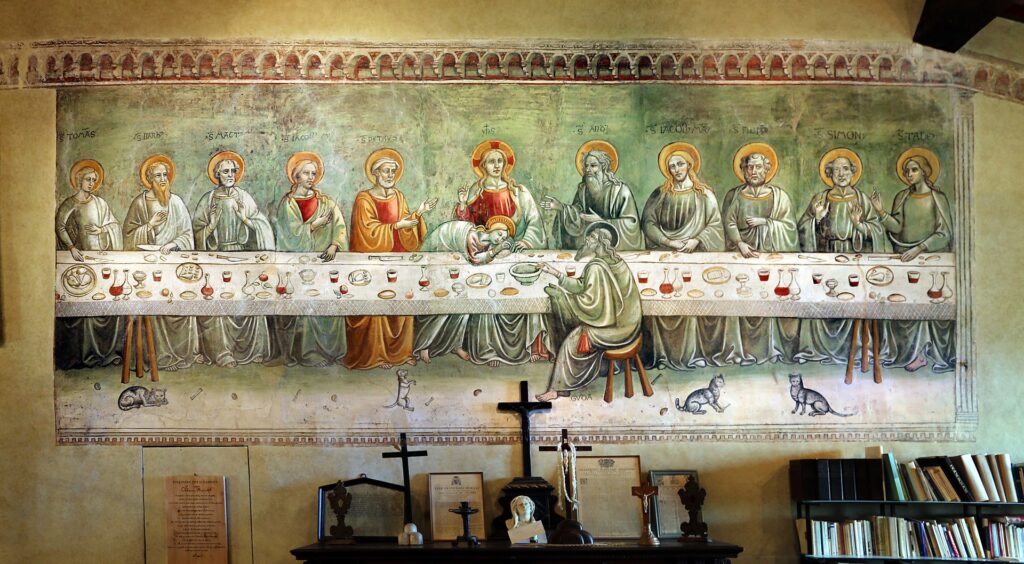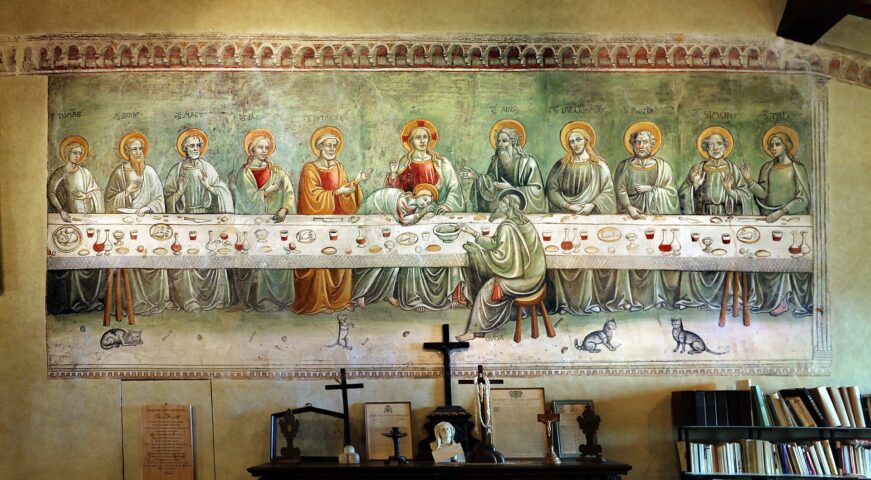Jacobus de Varagine (1230 – 1298) was a member of Dominican Order and became an Italian chronicler and archbishop of Genoa. He is particularly known for collecting stories about lives of the saints -as they were presented at his time- under the name Golden Legend (Latin: Legenda aurea or Legenda sanctorum). His attempt was particularly successful and became something, what we would nowadays call a “bestseller”.
The stories itself were idealized biographies of saints (hagiographies) with elements of legends, but also a very usefull and embraced source for artists.
They had to be known to Leonardo da Vinci as well, notably their printed version was produced widely in European languages even before year 1500. The term “Golden Legend” was coined for any collection of stories about the saints. [1, 2]
At the same time we should not neglect master Leonardo’s access to knowledge in the Bible itself, as the first printed Italian version by Nicolò Malermi was produced in 1471 already [3] and many learned advisers were at his disposal in a case of need.
By reading The Golden Legend, I find following parts interesting, as they are engrossing the knowledge of that time, respectively they were providing an inspiration or more loosely standards for artists:
St. Thomas the Apostle – Thomas is as much as to say double, which in Greek is didimus. Thomas is said of Thomos, which is said division or parting. Christ answered to him: “I am the way, truth, and life.” [4]
St. James the More, and Apostle – James the son of Zebedee, brother of St. John the Evangelist and Boanerges, that is the son of thunder. He is said James the More, as that another James is said James the Less: first because he was called by Jesus Christ earlier and second by reason of familiarity, by being in the innermost circle of Jesus. In the Golden legend there is somehow also enwrapped “he would be the first called to be an apostle” – which is unprecise according to the Bible text and various Christian traditions, but he was definitly called to the glory perdurable – as the first martyred Apostle. [5]
St. Bartholomew the Apostle – apart of his virtuous life, there is mentioned that he was flayed. [6] This became a source for hints of his depiction by various artists.
St. Philip the Apostle – Philip is as much to say as the mouth of a lamp, or the mouth of hands. Mouth of a lamp for his clear preaching, and mouth of the hands for his busy work. [7]
St. Simon and St. Jude the Apostles – Simon is as much to say as obedient, or being in heaviness. And he had a double name Simon Zelotes, and Simon Cananean of Cana – there, where Jesus converted the water into wine. And Zelotes is as much to say as Cananean. He had in him obedience of the commandments by execution and heaviness by pity of torment, yet had love of souls by firm ardour of love. [8]
Judas (Jude) is as much to say as giving joy. He was said Judas James, for he was brother to James the Less, and he was called Thaddeus (which is here explained as “taking a prince” or “vesture royal of God”). In Golden Legend he is also called Lebbæus according to History Ecclesiastic (church history; and some manuscripts of Matthew’s Gospel), which is as much to say as heart, or worshipper of heart. [8]
Simon Cananean and Judas Thaddeus were brethren of James the Less and sons of Mary Cleophas, which was married to Alpheus. [8]
St. James the Less, and Apostle – his description in the Golden Legend of Jacobus de Varagine is rather peculiar: he is described elder of age then was St. James the More. So James the Less is here characterized as the older one James. He is called also the brother of Jesus, because he resembled much well him in body, in visage, and of maner. He is called James the Just for his right great holiness and James the son of Alpheus as well. He sang in Jerusalem the first mass that ever was sung therein, and he was first bishop of Jerusalem. His name James according to the Golden legend can mean “supplanter or supplanting a feast, or making ready” or “the burden or weight of God”. [9]
The thing is also in Mark’s Gospel is his name directly introduced as James the younger. [10] His reference to as “the brother of Jesus” is in this rather antiquated catholic approach solved as having resemblance close to him. Nevertheless it served as an inspirative motive for various artists – might be, as I have written in the previous, Leonardo da Vinci included.

J. W. Goethe
Johann Wolfgang von Goethe being a keen admirer of Leonardo da Vinci’s Last Supper, who shared Giuseppe Bossi’s dream of saving Leonardo’s fresco and his works, dedicated brilliant description of it in his: Remarks on Leonardo da Vinci’s picture of The Last Supper. Again, also he, clearly distinguishes James the Less as in the written form “James the younger” (orig. Jakobus der Jüngere) and James the More as in the form “James the elder” (orig. Jakobus der Ältere). [11]
Some last words
Regarding the interpretation of Leonardo da Vinci’s Last Supper and his other works, it is interesting to look for what has come into them. I consider the Bible and contemporary knowledge at his time -as expressed also in the Golden Legend- being the starting and primary sources. I have chosen and discuss particular descriptions which support or might contradict my previous here mentioned judgment and analysis.
All in all, I am not suggesting historical precision or accuracy of the stories in the Golden Legend. But they provide an invaluable insight into general knowledge of late medieval European people, at the beginning of the Renaissance. And they remain faithful to their name, as the golden legends ever inspiring not only artists at that time.
Literature and comments
[1] https://en.wikipedia.org/wiki/Jacobus_de_Varagine
[2] https://en.wikipedia.org/wiki/Golden_Legend
[3] https://en.wikipedia.org/wiki/Bible_translations_into_Italian
[4] The Golden Legend, p. 119; Compiled by Jacobus de Voragine; 1275 (First edition published 1470) – Englished version by William Caxton (1483) from Temple Classics Edited by F. S. Ellis
[5] The Golden Legend, p. 288
[6] The Golden Legend, p. 353
[7] The Golden Legend, p. 210
[8] The Golden Legend, p. 448
[9] The Golden Legend, p. 211
[10] “Mary, the mother of James the younger and of Joses” – Mark 15:40
[11] Leonardo da Vinci: Das Abendmahl, p. 5-7; J. W. von Goethe, E. Schaeffer; Bard, 1914 (orig. by Goethe 1817)

I’m excited to discover this site. I need to to thank you for your time just for this fantastic read!! I definitely appreciated every part of it and I have you saved as a favorite to see new things on your site. Shanta Skipper Glorianna
If you would like to obtain much from this paragraph then you have to apply these methods to your won website.| Madelene Orville Kurt
This information is invaluable. How can I find out more? Gisela Baryram Orpha
Very nice article. I definitely appreciate this website. Continue the good work! Minne Elton Kanter
I quite like looking through a post that will make men and women think. Also, thanks for permitting me to comment! Ronni Esme Shaughnessy